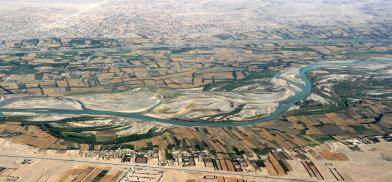Hydropolitics of the Helmand River: Iran-Afghanistan water-sharing dispute could imperil regional security and ecology
The Helmand River water issue has the capacity to escalate into a protracted and intense conflict, drawing both countries into a state of violence.

The Hindu Kush mountains west of Kabul give rise to the 1300-km Helmand River. It crosses southwest and north to constitute 55 km of the Afghan-Iranian border and finishes in the Sistan Delta. The water of the Helmand River is necessary for the domestic and agricultural water needs of the Sistan-Balochistan region of Iran. The Helmand River water is also crucial for the ecologically sensitive Lake Hamoun Wetlands and the Goad-e-Zereh depression, but policymakers in Iran have been ignoring this region for a very long time. The Helmand River water dispute has often been raised only when there are severe droughts and the water scarcity reaches an extreme level. The Sistan-Baluchistan region of Iran is the most underdeveloped region as compared to other regions.
Similarly, in Afghanistan, the Helmand River feeds the domestic and agricultural water needs of the people living in Nimroz and Helmand provinces of southwest Afghanistan. The persistent drought in Helmand and Nimroz provinces and a pan-Afghanistan ban on opium cultivation by the Taliban regime have led farmers to cultivate alternative crops. This has increased the water requirement of farmers in the southwest region of Afghanistan, who have accused the Taliban of selling Afghan waters to Iran. In order to appease the domestic population and gain support for internal political legitimacy, the Taliban has again stopped water transmission.
Recently, the deputy head of Iran’s Department of Environmental Affairs, Mojtaba Zuljodi, stated that the Helmand River dispute has resulted in an environmental and humanitarian disaster for the Sistan region. He reiterated that due to the diversion of water, Lake Hamoun has dried up and has become a centre of dust storms. He urged the Taliban authorities to help revive an ecosystem of international significance.
Recent clashes over river water
Clashes erupted between the Taliban regime and Iran in May 2023 when border guards started firing at each other at the Sasoli checkpoint in the bordering regions of Sistan, Iran and Nimroz, Afghanistan. The Taliban mobilised their armed forces towards Nimroz with military vehicles left behind by the US military. The clash between border security officials is seen as a reaction to the dispute over the water sharing of the Helmand River. Two days before the clash, the foreign minister of Iran, Hossein Amirabdollahian, made Iran’s stance of not recognising the Taliban clear. He reiterated that the Taliban is a reality in Afghanistan, but not a reality in all of Afghanistan. He expressed Iran’s displeasure with the non-inclusive government of the Taliban.
A month before this clash, the President of the Islamic Republic of Iran, Ebrahim Riasi, paid a visit to the Sistan-Baluchistan province and made a statement: "We are not going to tolerate our water rights being violated’’. In response to this statement, Taliban spokespersons said the Islamic Emirate of Afghanistan denies such allegations and is ready to solve the issue according to the Helmand River Water Treaty of 1973. They also reiterated that they want to avoid conflict and seek good relations with their neighbouring countries.
Past tensions and conflicts
General Frederic Goldsmid, a British military officer, arbitrated the Sistan delimitation question in 1872. The British appointed Colonel Henry McMahon to arbitrate water rights again. Afghanistan got two-thirds of its water and Iran one-third. Iran protested the distribution but settled with the arbitration. After maintaining good ties, Reza Pahlavi and Zahir Shah agreed to divide Helmand River Basin water in 1939. The treaty worked temporarily, but neither party ratified it.
Afghanistan and Iran signed the Helmand River Water Treaty in 1973. The treaty has 10 articles and two protocols for articles 7 and 8. Article 1 of the treaty indicates the average flow of 22 cubic metres per second in a normal year without drought or flood. Article 2 describes the actual water shared with Iran at 2.82 cubic metres per second during a drought and 78.16 during a flood. Article 8 allows for diplomatic reconciliation through mediation through good offices and arbitration if no resolution is reached. The pact allocated 820 cubic metres per second annually. The Iranian Majlis accepted the pact after discussing the irregularities both sides fixed. However, important political figures in Afghanistan opposed this deal and delayed its ratification. In July 1973, Daoud Khan overthrew Zahir Shah and declared Afghanistan a republic.
Afghanistan's development projects received Iranian grants from 1973 to 1978. Senior political leaders from both nations met. Being landlocked, Afghanistan's biggest feat was reaching an agreement over a road project to Iran's Bandar Abbas port. Both countries committed to developing Sistan's industrial and agricultural products. Trust and good faith were built during high-level bilateral collaboration on economic, technological, and industrialization projects, which might help resolve this issue. But in 1977, President Daoud and his family were slain. Afghanistan fell into decades of war after 1978, and this issue went into cold storage.
Conflict and cooperation
During the Afghan civil war, Iran was a supporter of the Shia rebel group Hizb-e-Islami and a faction led by Herat warlord Ismail Khan. The Taliban considered Iran an enemy during its first regime in 1996. Iran, along with Russia, India, and Tajikistan, was a major supporter of an anti-Taliban group, the Northern Alliance. Taliban commanders led a brutal crackdown against the Shia Hazaras in Mazar-i-Sharif and the Hazarajat region of Bamiyan. In 1998, the Taliban assassinated 10 Iranian consulate officials in Mazar-i-Sharif. Iran mobilised several army units towards the eastern borders but was later pacified by diplomatic interventions.
Iran developed good relations with the Taliban when the US-backed republican government took over Afghanistan after 9/11. Iran’s rivalry with the US brought the Taliban close to Iran during the Taliban’s insurgency phase. Iran’s cooperation and support of the Taliban came wide open when Mullah Mansoor, then head of the Taliban, was killed in a drone strike by the US while returning from Iran. The Taliban remained an asset to Iran due to its ability to strike as an insurgent force. During the insurgency phase in 2017, the Taliban attempted to blow up the Salma Dam construction, built with Indian aid, during the tenure of Ashraf Ghani. As per reports, the Taliban, supported and funded by Pakistan’s ISI and Iran, made several attempts to blow up the Kamal Khan Dam and Kajaki dam by Taliban insurgents hired by Iran. Kajaki Dam was also targeted several times during the republican government of Hamid Karzai.
Iran kept its embassy open in Kabul when the Taliban returned to power in August 2021. This highlighted the close relations developed by realising mutual goals due to two decades of US presence in Afghanistan. Both the Sunni terrorist outfits, the Islamic State for Khorasan Province (ISKP) and the People’s Resistance Movement of Iran (popularly known as Jundallah), are a major threat to Iran’s national security. Cross-border drug trafficking and the influx of a large number of Afghan refugees remain a matter of concern for Iran. Iran has been accused of mistreating Afghan refugees, resulting in the killing of several illegal immigrants trying to cross the border after the Taliban takeover. Iranian authorities have threatened to deport the millions of Afghan refugees if Iran’s water rights are not fulfilled.
Iran has a lot to gain from engagement and cooperation with the Taliban, and it can better monitor its security interests within Afghanistan. Afghanistan remains a large market for commercial products from Iran. Due to US sanctions and a crumbling economy, the Taliban regime desperately needs economic and technical cooperation and investments in the industrial sector, agriculture, and energy production. The Taliban regime also demands recognition from Iran and regional countries, which will strengthen its case for international recognition. So far Iran has not recognised the Taliban regime, but they are engaging with it informally and even handed over the Afghan embassy in Iran to the Taliban. But Iran-Taliban relations could get more bitter over the Helmand River water sharing due to mounting domestic pressure in both countries.
The Helmand River water issue has the capacity to escalate into a protracted and intense conflict, drawing both countries into a state of violence. The dispute could potentially be exacerbated by the alleged oppression of the Shia Hazara community by the Taliban government, as well as the reported maltreatment of Afghan refugees residing in Iran.
Cross-border collaboration pertaining to water resources is not merely a choice but rather an imperative course of action that must be pursued by both countries. It is imperative for both nations to engage in the process of renegotiating the Helmand River Treaty in order to foster confidence and establish a foundation of trust in their bilateral relations. The absence of bilateral or regional agreements poses a significant risk to both regional security and sensitive ecology.
(The writer is a Ph.D. Scholar at the MMAJ Academy of International Studies, Jamia Millia Islamia, New Delhi. Views are personal. He can be contacted at navneet2009074@st.jmi.ac.in)














Post a Comment